Abstract
The methodology for the adaptive e-learning resources implementation based on the LMS Moodle electronic environment current versions are presented. An individual educational trajectory formation features, the personalized educational content creation and implementation intended for the theoretical material study, using the LMS Moodle instrumental apparatus are considered. An approach to dividing the material into editions, depending on the students' psychophysiological characteristics, is described. The problems that limit the electronic environment LMS Moodle using the current versions' possibility in the adaptive e-learning resources development are identified and their solution ways are proposed. The methodology implementation technology for determining the dominant perceptual modality of students based on the built-in LMS Moodle instrumental apparatus using test elements united by a logical transitions system is presented. Algorithms for generating personalized learning content for students with different dominant perceptual modality, including for the most complex category in this context, kinetics, are considered. On the practical experience basis, a conclusion was made about the built-in LMS Moodle current versions instrumental apparatus using possibilities and prospects for the individual educational trajectories' formation.
Keywords: Adaptive e-learning resource, individual educational trajectory, personalized learning content, video lecture, LMS Moodle
Introduction
According to Assante et al. (2017), adaptive learning is a teaching model that involves the optimal educational trajectory construction under the student individual characteristics: the input knowledge level, psychophysiological characteristics, the mastering of the discipline sections effectiveness, an educational process comfortable organization possibilities, etc. As shown by Pozharkova, et al. (2018), such a model can be implemented through adaptive e-learning resources (AER) based on e-learning platforms, such as LMS Moodle, which are an educational process organizing modern and effective means using information and communication technologies, providing remote access to educational resources, and using an interaction between students and teachers network means wide variety.
Problem Statement
In the AER practical implementation, the developer faces difficulties a number that is associated with the e-learning platforms instrumental apparatus often insufficient development, which is necessary for an individual educational trajectory automatic formation and the personalized educational content implementation. According to Gess-Newsome et al. (2019), the theoretical material study structured by topic is a knowledge acquiring system process integral part in a discipline by a student, which is the basis for the skills and abilities development, and, ultimately, the competencies' formation. This article presents the implementing ESM components experience in the LMS Moodle e-learning environment, concerning an individual educational trajectory creation when studying theoretical material in engineering and technical disciplines.
According to Pozharkova (2019), the educational trajectories branching points in the knowledge formation within the studied discipline are input testing and the mastering theoretical material results testing in the section.
Personalized educational content for the knowledge formation when mastering the discipline section theoretical part is presented in three editions (A, B, C). The edition type available to the student during the theoretical material initial study is determined by the entrance testing results, the other two editions are blocked. In the unsatisfactory test results case in the section theoretical part, the student sequentially becomes available to the educational material remaining editions.
The approaches one to an individual educational trajectory formation in the theoretical material study, used by the author in the AER development, is the material division into editions depending on the student dominant perceptual modality: information perception visual leading type - visual perception dominates, auditory - auditory perception and kinaesthetic - tactile perception.
The student dominant perceptual modality diagnostics is carried out according to the S. Efremtseva method, described by Grebenshchikov (2017), in the course entrance testing. S. Efremtseva's methodology implies that the respondent chooses one of two answer options, depending on his psychophysiological preferences (Figure. 1). The questions are divided into several categories (visual, auditory, kinaesthetic), corresponding to the perception main types identified by the leading types, the test result is determined under the affirmative answers' number in each category. The category in which the respondent gives the affirmative answers the greatest number corresponds to his dominant perceptual modality.
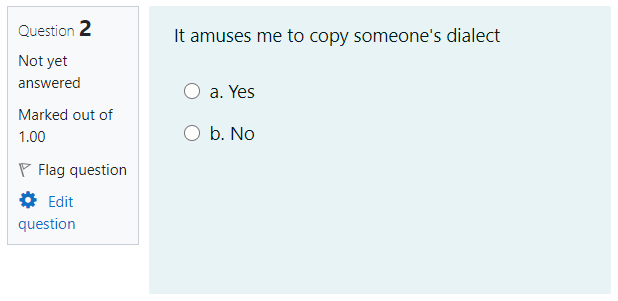
As noted by Cabero-Almenara et al. (2019), the available testing tools LMS Moodle (version 3.11 and below) do not allow the test results formation by the selected answer options number in several categories, and also do not provide an opportunity to use two tests results in comparison when describing the conditions for accessing a course element between themselves. In the using third-party testing resources case, for example, Google Forms, the implementing automatic data exchange problem arises between them and LMS Moodle, according to Simanullang and Rajagukguk (2020). At the same time, manual loading students test results by the teacher for further use in the AER contradicts the forming educational trajectories automating the process concept by an e-learning platform means.
Research questions
In this work, the following issues' study was carried out:
- The algorithm implementation for determining the students' dominant perceptual modality based on the LMS Moodle current versions built-in tools.
- Methodology development for creating personalized educational content based on built-in tools for LMS Moodle current versions.
Purpose Of The Study
This work-study purpose is to assess the e-learning environment LMS Moodle prospects, as a means for the individual educational trajectories' implementation and educational content placement.
Research Methods
The author used scientific research such methods as analysis, synthesis and modelling.
Algorithm for determining the students' dominant perceptual modality
To implement the S. Efremtseva described a testing technique in LMS Moodle, three-Test elements are used, united by logical transitions system, under the algorithm shown in Figure. 2. Answers to questions are coded 1 or -1 by points assigning an appropriate number for an affirmative answer and are divided into the following groups:
- VA group: contains questions related to the categories visual (assigned 1 point for an affirmative answer) and audial (assigned -1 point for an affirmative answer).
- VK group: contains questions related to the categories visual (assigned 1 point for an affirmative answer) and kinesthetic (assigned -1 point for an affirmative answer).
- AK group: contains questions related to the categories audial (assigned 1 point for an affirmative answer) and kinesthetic (assigned -1 point for an affirmative answer).
Questions in groups are not duplicated. The dominant perceptual modality determination is carried out by the student's sequential exclusion belonging to the types' rest under the algorithm (Figure 2). Based on the test results, the student automatically gets access to the educational material corresponding edition: edition A - for students-audials, B - visuals, C - kinesthetics.
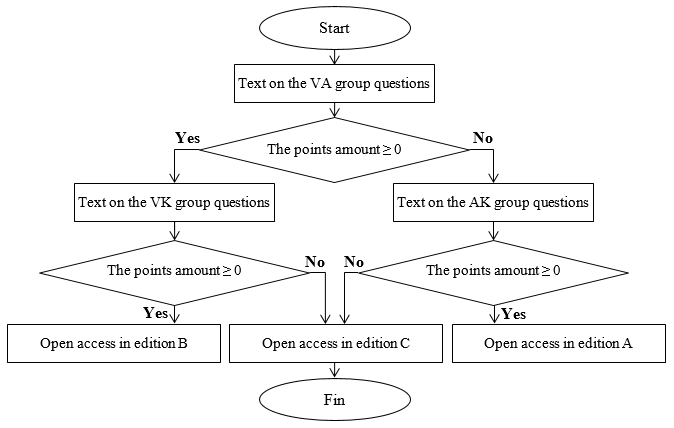
Methodology for creating personalized learning content
The next stage in the AER preparation is the personalized educational content creation for the theoretical material study in the discipline section.
According to Nuraida and Amam (2019), when implementing an individual educational trajectory construction under the dominant perceptual modality for visual learners, theoretical material is presented in text form using the LMS Moodle elements File (document in pdf format) or Page (document in Html format).
Theoretical material for students-auditors in the AER is presented in a video lecture form with sound accompaniment. As shown by Hung and Chen (2018), ready-made educational video content distributed by the authors or freely available on the Internet for engineering and technical profile in most special disciplines can be used only fragmentarily due to inconsistency with the academic disciplines working programs sections. Thus, it is often necessary to create educational video content by the AER author.
According to Scagnoli et al. (2019), in practice, the creating video lectures process has not been sufficiently developed and often causes difficulties, including those related to the teaching in engineering and technical disciplines peculiarities, involving the information transfer to students from the lecturer not only verbally (speech), but also using the symbols' language (for example, for writing formulas), graphic images, diagrams, drawings, etc. Pozharkova et al. (2017) describes creating educational video content technology in a slide lecture form, as the least time-consuming option for a teacher, which eliminates the need for a teacher to have special skills (actor, director, operator, video editor). These lectures type can be created without special equipment use, using only a personal computer. The slide lecture development process includes the following steps:
- A soundtrack creation (audio track) of a video lecture by reading a previously prepared text by the lecturer himself, or by a specialized program.
- A video stream creation (video track) based on prepared and animated slides set that provide text and graphic support for a lecture using video capture from a computer screen (screencasting) using special applications.
- Video editing in computer video editing programs, which can be linear, i.e. consist of combining an audio track and a video stream, or nonlinear, if additional fragments, visual effects, text comments, etc. are to be introduced into the video.
- Converting video into AVI, mp4, FLV, etc. format, available for implementation in the e-learning system, carried out by a video editing program.
Findings
The algorithm Implementation for determining the students' dominant perceptual modality
The algorithm presented in Figure 2 is implemented on a student's access managing the conditions' basis to the theoretical material addition, taking into account the entrance testing and/or test results for the section. These conditions are set in the window for editing the corresponding LMS Moodle component settings by describing the restrictions on access to it for the course user (Figure 3, 4). The condition for opening the student's access to the training material alternative version is unsatisfactory test results for the section (Figure 3, 4).
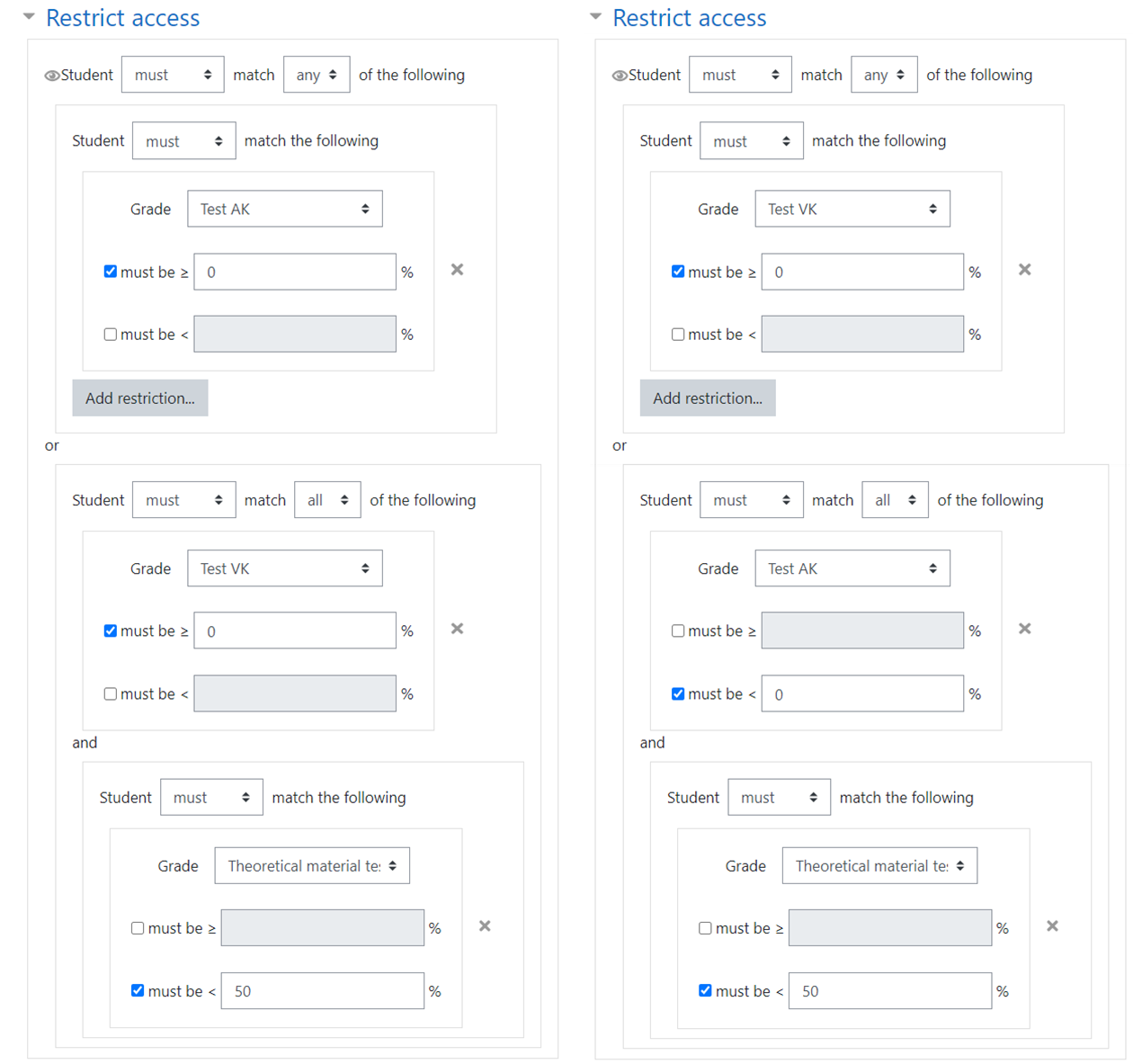
The methodology for creating personalized training content implementation
Of particular interest is the theoretical material creation for kinaesthetic students who perceive information primarily through tactile sensations and movements. For such students, the theoretical material is proposed to be implemented by the LMS Moodle Test element in an interactive lecture kind form with the following structure:
- text theoretical material block;
- test questions such as drag to an image, drag to text, drag markers that use the Drag-and-drop technology (an operating interface elements method using a mouse manipulator, touch screen or touchpad) (Figure 5).
Figure 5 shows such a question an example: a question (Figure 5, a), to answer which, you need to grab the element with mouse and drag it to the diagram corresponding area (Figure 5, b).
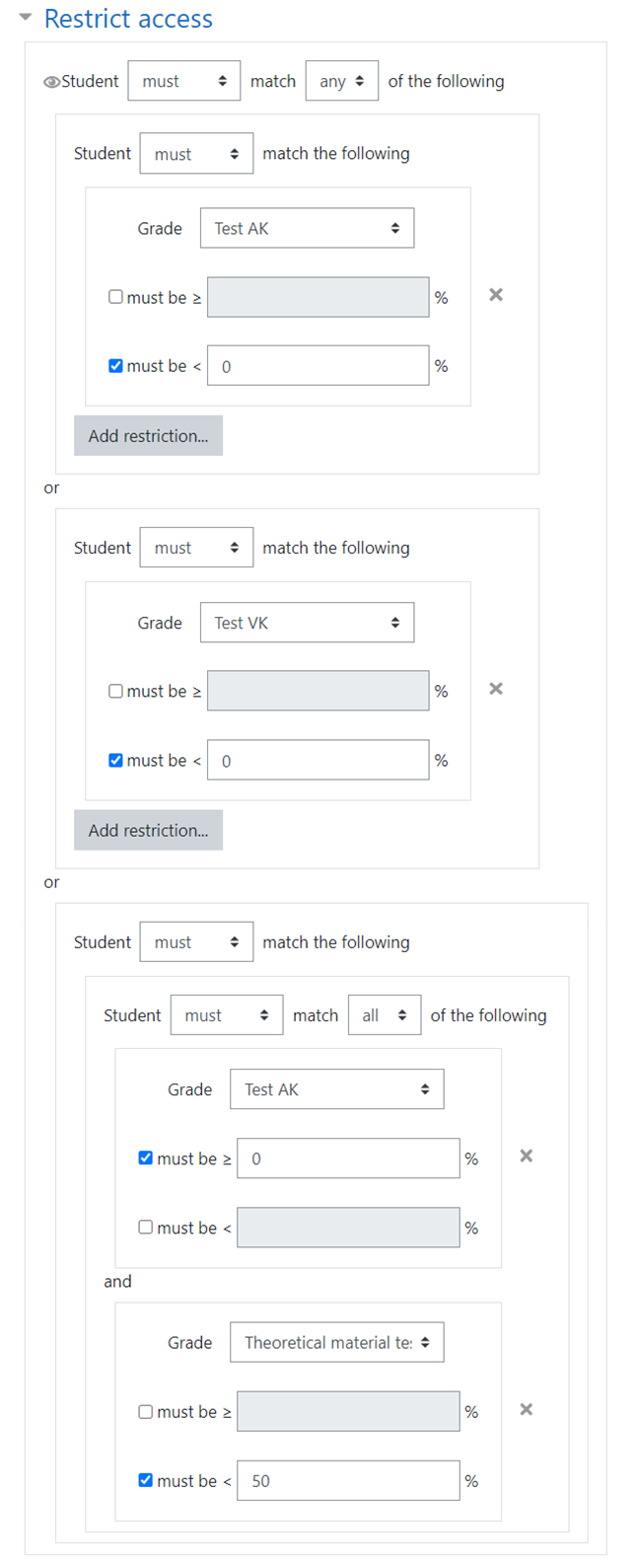

As a drag to image type question parameters, you need to load a file with a background image (Figure 6), files with images to be moved, or enter the desired text in the Dragged element field (Figure 6), and also specify the zones for placing elements on a background image, corresponding to the correct answer (Figure 6), by setting their coordinates or moving to the background image desired area.
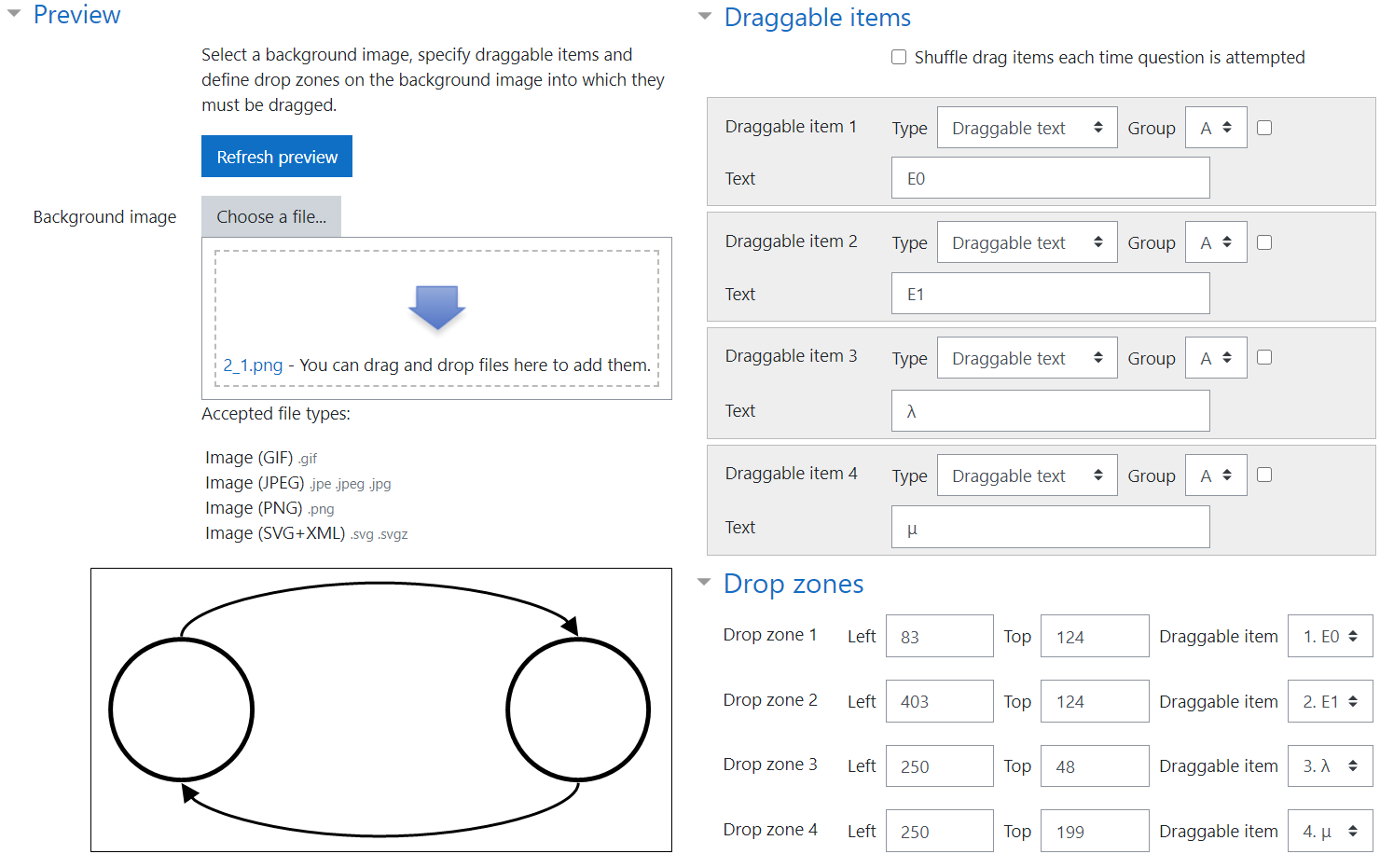
Unfortunately, the lectures' presentation described form for kinaesthetics cannot be implemented with the interactive element LMS Moodle Lecture, because it does not support the questions' type using the Drag-and-drop technology, but can include only the questions' the simplest types: multiple-choice, for compliance, etc.
Conclusion
The experience gained by Pozharkova (2020) in the AER implementation showed that the LMS Moodle e-learning platform contains tools a wide range for implementing individual educational trajectories and placing educational content, which makes organizing the educational process effective means in a virtual environment using the adaptive learning principles. At the same time, problems a number were identified that limit the LMS Moodle current versions use in the AER implementation, namely: a testing tool lack with counting the answers' number by category; data automatic loading impossibility (for example, test results) from third-party Internet resources, the student's work time automatic recording lack with the course elements File, Page, etc. to assess the discipline section complexity; test questions limited types in the interactive element Lecture.
References
Assante, D., Fornaro, C., Weitschek, E., Castro, M., Martin, S., Hamburg, I., & Cotovanu, A. M. (2017). Smart open online tool for adaptive education on Cloud Computing, IEEE Global Engineering Education Conference (EDUCON). 1183-1186.
Cabero-Almenara, J., Arancibia, M., & Del Prete, A. (2019). Technical and didactic knowledge of the Moodle LMS in higher education. Beyond functional use. Journal of New Approaches in Educational Research (NAER Journal), 8(1), 25-33.
Gess-Newsome, J., Taylor, J. A., Carlson, J., Gardner, A. L., Wilson, C. D., & Stuhlsatz, M. A. (2019). Teacher pedagogical content knowledge, practice, and student achievement. International Journal of Science Education, 41(7), 944-963.
Grebenshchikov, G. F. (2017). Towards the diagnosis of the mathematics masters dominant perceptual modality in the pedagogical institute. Pedagogy and modernity, 1, 9-13.
Hung, I. C., & Chen, N. S. (2018). Embodied interactive video lectures for improving learning comprehension and retention. Computers & Education, 117, 116-131.
Nuraida, I., & Amam, A. (2019). Hypothetical learning trajectory in realistic mathematics education to improve the mathematical communication of junior high school students. Infinity Journal, 8(2), 247-258.
Pozharkova, I. N. (2019). Methodology for creating personalized learning content. Open and Distance Education, 2(74), 51-63.
Pozharkova, I. N. (2020). The method for developing practice-oriented skills when studying the Control System Modeling course in the e-learning environment. Journal of Physics: Conference Series, 1691(1), 012139.
Pozharkova, I. N., Lagunov, A. N., Troyak, E. Yu., & Gaponenko, M. V. (2017). Video lectures in the distance learning system of the EMERCOM universities of Russia. Natural and technogenic risks (physical, mathematical and applied aspects), 3(23), 59-66.
Pozharkova, I. N., Noskova, E. E., & Troyak, E. Yu. (2018). An individual educational trajectory formation as a practice-oriented learning environment component. Pedagogical Image, 3(40), 179-192.
Scagnoli, N. I., Choo, J., & Tian, J. (2019). Students' insights on the use of video lectures in online classes. British Journal of Educational Technology, 50(1), 399-414.
Simanullang, N. H. S., & Rajagukguk, J. (2020). Learning Management System (LMS) Based On Moodle To Improve Students Learning Activity. Journal of Physics: Conference Series, 1462(1), 012067.
Copyright information

This work is licensed under a Creative Commons Attribution-NonCommercial-NoDerivatives 4.0 International License.
About this article
Publication Date
25 September 2021
Article Doi
eBook ISBN
978-1-80296-115-7
Publisher
European Publisher
Volume
116
Print ISBN (optional)
-
Edition Number
1st Edition
Pages
1-2895
Subjects
Economics, social trends, sustainability, modern society, behavioural sciences, education
Cite this article as:
Pozharkova, I. N. (2021). The Prospects Assessment For The Individual Educational Trajectories Implementation In Moodle. In I. V. Kovalev, A. A. Voroshilova, & A. S. Budagov (Eds.), Economic and Social Trends for Sustainability of Modern Society (ICEST-II 2021), vol 116. European Proceedings of Social and Behavioural Sciences (pp. 1194-1202). European Publisher. https://doi.org/10.15405/epsbs.2021.09.02.132

